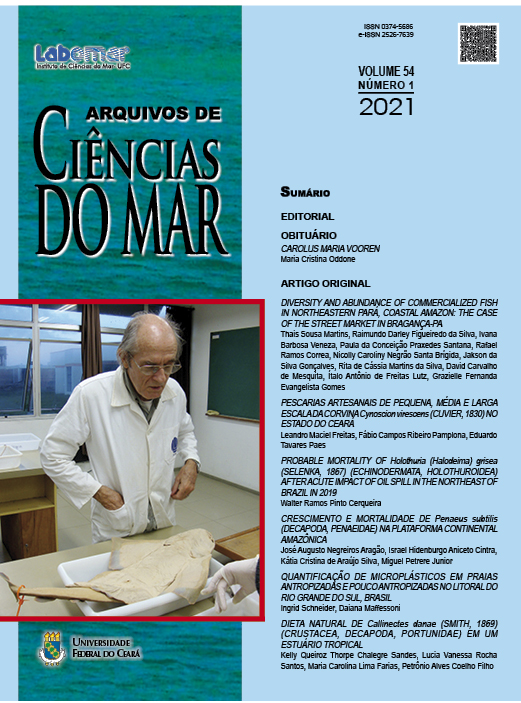Preliminary bycatch list of trawl fishing mollusks on the amazon continental platform
DOI:
https://doi.org/10.32360/acmar.v54i1.42007Abstract
Motorized trawl fishing is considered highly predatory due to the accidental capture of numerous organisms. Based on the context and due to the need for knowledge about the malacofauna associated with industrial fishing in the Amazonian Platform, the present study aims to characterize the accompanying malacofauna. The samples were collected in 2016, 2017 and 2018, 250 trawls were monitored. 30 and 80 meters in 22 fisheries, 4,834 molluscs were collected, distributed in five classes (Bivalvia, Cephalopoda, Gastropoda, Polyplacophora and Scaphopoda), and 81 species. The class that presented the greatest diversity was the gastropod followed by the bivalves in relation to abundance. The species that stood out were the cephalopods Doryteuthis sp. e Lolliguncula brevis, the gastropods Hydatina physis; Marsupina bufo; Tonna galea; Turbinella laevigata; Stigmaulax cayenensis; Calyptraea centralis; Conasprella janowskyae and Polystira coltrorum, the abundance model that characterizes the region and the geometric type, where few species are dominant and the other rare species. The area studied is important in terms of conservation of marine biodiversity given the presence of species of economic interest and the existence of a wide diversity of species.
Keywords: mollusk, diversity, invertebrates, amazonian platform.
Downloads
Published
Issue
Section
License
1. Proposta de Política para Periódicos de Acesso Livre
Autores que publicam nesta revista concordam com os seguintes termos:
- Autores mantém os direitos autorais e concedem à revista o direito de primeira publicação, com o trabalho simultaneamente licenciado sob a Licença Creative Commons Attribution que permite o compartilhamento do trabalho com reconhecimento da autoria e publicação inicial nesta revista.
- Autores têm autorização para assumir contratos adicionais separadamente, para distribuição não-exclusiva da versão do trabalho publicada nesta revista (ex.: publicar em repositório institucional ou como capítulo de livro), com reconhecimento de autoria e publicação inicial nesta revista.
- Autores têm permissão e são estimulados a publicar e distribuir seu trabalho online (ex.: em repositórios institucionais ou na sua página pessoal) a qualquer ponto antes ou durante o processo editorial, já que isso pode gerar alterações produtivas, bem como aumentar o impacto e a citação do trabalho publicado (Veja O Efeito do Acesso Livre).

